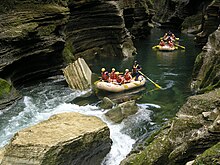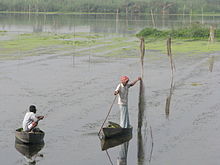This article includes a list of general references, but it lacks sufficient corresponding inline citations. (October 2017) |
| Ramsar Convention on Wetlands of International Importance Especially as Waterfowl Habitat | |
|---|---|
 Ramsar logo | |
| Signed | 2 February 1971 |
| Location | Ramsar, Iran |
| Effective | 21 December 1975 |
| Condition | Ratification by 7 states |
| Signatories | 23[1] |
| Parties | 172[1] |
| Depositary | Director General of UNESCO |
| Languages | English (prevailing in case of divergence), French, German, Russian and Spanish[1] |
The Ramsar Convention on Wetlands of International Importance Especially as Waterfowl Habitat is an international treaty for the conservation and sustainable use of Ramsar sites (wetlands).[2] It is also known as the Convention on Wetlands. It is named after the city of Ramsar in Iran, where the convention was signed in 1971.
Every three years, representatives of the contracting parties meet as the Conference of the Contracting Parties (COP), the policy-making organ of the convention which adopts decisions (site designations, resolutions and recommendations) to administer the work of the convention and improve the way in which the parties are able to implement its objectives.[3] In 2022, COP14 was co-held in Wuhan, China, and Geneva, Switzerland.


- ^ a b c "Convention on Wetlands of International Importance especially as Waterfowl Habitat". UNESCO. Retrieved 7 August 2022.
- ^ "The Ramsar Convention and its Mission". Archived from the original on 9 April 2016. Retrieved 11 October 2016.
- ^ "The Conference of the Contracting Parties". Ramsar. Retrieved 31 March 2019.